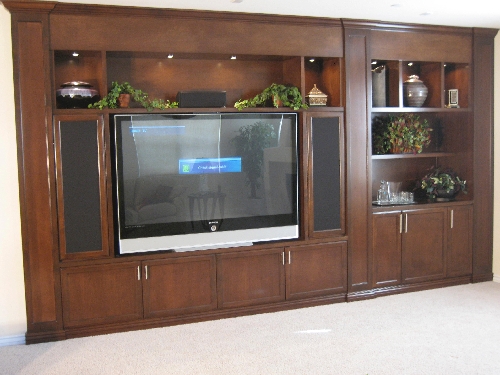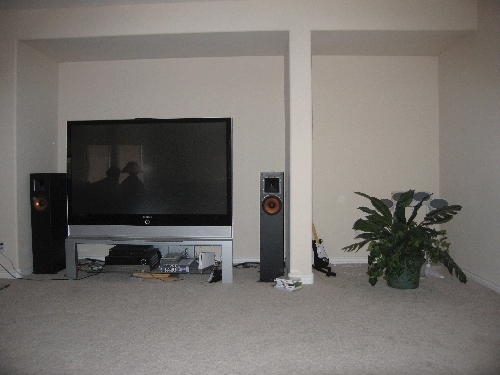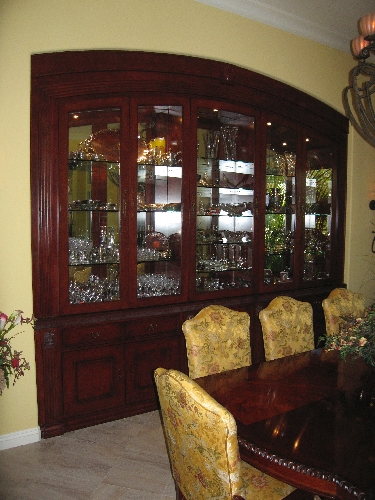Design makes cabinetry beautiful as well as functional



It’s been said that two things are inevitable: death and taxes. But, for a designer and almost any homeowner, there is a third — and that’s the dreaded long, blank wall. You know it as the one with the new flat-screen TV supported temporarily (so you tell everyone), by that old, ratty chest of drawers that you’ve had forever, and surrounded by the odd assortment of audio components and tangled wires. And all the while you’re hoping and looking forward to giving them a new home in some glorious designer-style cabinet.
That cabinet has been at the top of your to-do list for awhile, but somehow it keeps slipping to a lower priority as the uncertainty mounts as to how and where to begin with such an important and overwhelming project.
“God forbid I make a mistake and mess up,” you say to yourself, “and then wind up with something I don’t really like or isn’t right for the room and I’ll have wasted all that money and effort.”
And so you wait and wait — hoping for some divine guidance from above — or from somewhere — anywhere.
What do you do? Who do you call? Realizing that even though that mess of cables may look like a job for the Geek Squad, you’re initial thought is to contact a cabinet man or some carpenter. And that’s your first mistake.
Determining the right style and scale of the cabinet for your room is just as important as how the cabinet is built. And for that first major and fundamental step in the design/build process, you should be calling a reputable interior designer, preferably one that has had a great deal of experience in designing and building custom furniture. It’s that professional who will know just what your cabinet should look like, the size it will need to be, the finish, etc. And no doubt they’ll also know what qualified finish carpenter to choose in order to create the cabinet of your dreams.
A reputable professional interior designer is trained to listen to peoples’ needs and wishes, interpreting them and then coming up with the right design that will not only be creative, but functional as well. In a word, if you’re hoping for the cabinet of your dreams, my advice is to go this route and confer with a knowledgeable professional before you do anything else.
Hopefully, that person will approach your project the way I always do — more like designing a fine piece of furniture rather than just some storage cabinet. Even if your unit is to serve the most basic of needs, there’s no reason that you can’t make it interesting. A good designer will encourage you to think out of the box while still allowing form to follow function in the execution of your design.
What this means is that the form or design must serve the purpose for which it is created. If you do that, there is little chance that you will ever go wrong. To this end, it’s important to keep in mind that a cabinet must, of necessity, always be built “from the inside out.” In other words, what has to be determined first is the size of the contents to be stored if the unit is to meet its goal upon completion. Of course, whatever remaining space there is, can be dedicated to additional storage and/or display areas.
Other key components of my to-do list include the following: the overall look and design of your cabinet should work with the basic design and architecture of your home. For example, if your home is contemporary, then flat-panel doors, clean lines and simplicity should be your goal, complemented by a sleek finish. No knotty-pine, please!
Try to make a statement with your unit. In other words, don’t be shy, but consider a cabinet that goes wall-to-wall and floor-to-ceiling for the most dramatic and effective use of the space while at the same time trying to unify any disparate elements, such as a fireplace and separate storage area, by integrating them into the overall design. Adding a mantel to the fireplace is always a great idea as well as integrating (if possible) any of those nasty drywall niches you may have by cladding them in the same finish.
Include lighting in your display areas. Adding a finished back to the unit is a must for any kind of an upscale look, along with the addition of crown molding at the top, either simple or elaborate, depending on the look you want to achieve. And if you should encounter a support beam that gets in the way, then go ahead and be sure to clad it in wood, turn it into a beautiful column, and incorporate it into the final design. Oh, and don’t forget the wonderful functionality and convenience of slide-out shelves (hidden behind doors, of course) and made even more purposeful with a lip to keep things from sliding forward and tumbling onto the floor.
In a word then, don’t do it yourself, but rather seek out professional guidance when attempting any kind of custom cabinetry for your home. Make it your goal to bring design in the placement of those simple horizontal planks of wood and you’ll soon stop seeing a wall unit as just a frame with shelves and nothing more.
Stephen Leon is a licensed interior designer and president of Soleil Design International; he has been designing and manufacturing custom furniture and cabinetry for more than 25 years. He has served on the board of directors of the Central California/Nevada Chapter of the American Society of Interior Designers and is a certified professional in green residential design. Questions can be sent to stephen@soleildesigninter
national.com.












